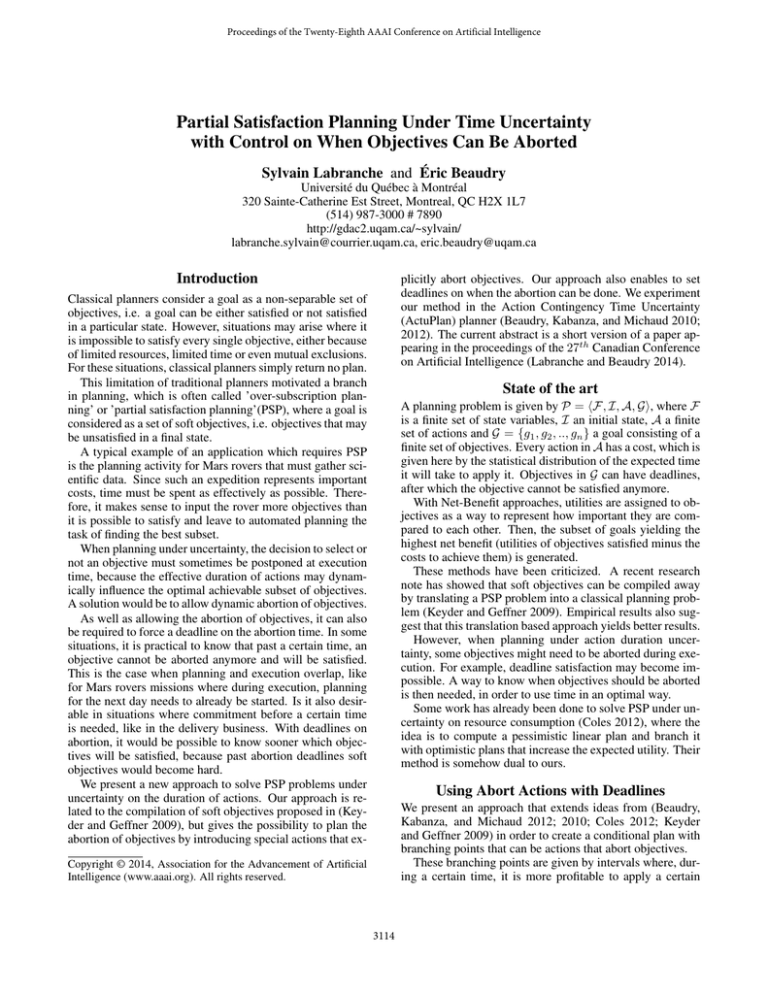
Proceedings of the Twenty-Eighth AAAI Conference on Artificial Intelligence
Partial Satisfaction Planning Under Time Uncertainty
with Control on When Objectives Can Be Aborted
Sylvain Labranche and Éric Beaudry
Université du Québec à Montréal
320 Sainte-Catherine Est Street, Montreal, QC H2X 1L7
(514) 987-3000 # 7890
http://gdac2.uqam.ca/~sylvain/
labranche.sylvain@courrier.uqam.ca, eric.beaudry@uqam.ca
Introduction
plicitly abort objectives. Our approach also enables to set
deadlines on when the abortion can be done. We experiment
our method in the Action Contingency Time Uncertainty
(ActuPlan) planner (Beaudry, Kabanza, and Michaud 2010;
2012). The current abstract is a short version of a paper appearing in the proceedings of the 27th Canadian Conference
on Artificial Intelligence (Labranche and Beaudry 2014).
Classical planners consider a goal as a non-separable set of
objectives, i.e. a goal can be either satisfied or not satisfied
in a particular state. However, situations may arise where it
is impossible to satisfy every single objective, either because
of limited resources, limited time or even mutual exclusions.
For these situations, classical planners simply return no plan.
This limitation of traditional planners motivated a branch
in planning, which is often called ’over-subscription planning’ or ’partial satisfaction planning’(PSP), where a goal is
considered as a set of soft objectives, i.e. objectives that may
be unsatisfied in a final state.
A typical example of an application which requires PSP
is the planning activity for Mars rovers that must gather scientific data. Since such an expedition represents important
costs, time must be spent as effectively as possible. Therefore, it makes sense to input the rover more objectives than
it is possible to satisfy and leave to automated planning the
task of finding the best subset.
When planning under uncertainty, the decision to select or
not an objective must sometimes be postponed at execution
time, because the effective duration of actions may dynamically influence the optimal achievable subset of objectives.
A solution would be to allow dynamic abortion of objectives.
As well as allowing the abortion of objectives, it can also
be required to force a deadline on the abortion time. In some
situations, it is practical to know that past a certain time, an
objective cannot be aborted anymore and will be satisfied.
This is the case when planning and execution overlap, like
for Mars rovers missions where during execution, planning
for the next day needs to already be started. Is it also desirable in situations where commitment before a certain time
is needed, like in the delivery business. With deadlines on
abortion, it would be possible to know sooner which objectives will be satisfied, because past abortion deadlines soft
objectives would become hard.
We present a new approach to solve PSP problems under
uncertainty on the duration of actions. Our approach is related to the compilation of soft objectives proposed in (Keyder and Geffner 2009), but gives the possibility to plan the
abortion of objectives by introducing special actions that ex-
State of the art
A planning problem is given by P = hF, I, A, Gi, where F
is a finite set of state variables, I an initial state, A a finite
set of actions and G = {g1 , g2 , .., gn } a goal consisting of a
finite set of objectives. Every action in A has a cost, which is
given here by the statistical distribution of the expected time
it will take to apply it. Objectives in G can have deadlines,
after which the objective cannot be satisfied anymore.
With Net-Benefit approaches, utilities are assigned to objectives as a way to represent how important they are compared to each other. Then, the subset of goals yielding the
highest net benefit (utilities of objectives satisfied minus the
costs to achieve them) is generated.
These methods have been criticized. A recent research
note has showed that soft objectives can be compiled away
by translating a PSP problem into a classical planning problem (Keyder and Geffner 2009). Empirical results also suggest that this translation based approach yields better results.
However, when planning under action duration uncertainty, some objectives might need to be aborted during execution. For example, deadline satisfaction may become impossible. A way to know when objectives should be aborted
is then needed, in order to use time in an optimal way.
Some work has already been done to solve PSP under uncertainty on resource consumption (Coles 2012), where the
idea is to compute a pessimistic linear plan and branch it
with optimistic plans that increase the expected utility. Their
method is somehow dual to ours.
Using Abort Actions with Deadlines
We present an approach that extends ideas from (Beaudry,
Kabanza, and Michaud 2012; 2010; Coles 2012; Keyder
and Geffner 2009) in order to create a conditional plan with
branching points that can be actions that abort objectives.
These branching points are given by intervals where, during a certain time, it is more profitable to apply a certain
Copyright © 2014, Association for the Advancement of Artificial
Intelligence (www.aaai.org). All rights reserved.
3114
they show that is it possible to have the information on the
maximum time when objectives will be aborted without necessarily incurring additional execution costs.
In general, the method is not yet scalable to bigger problems, because the abort actions approach in itself makes the
state space quite larger. Ways to reduce this state space explosion will be investigated.
action while, once the interval is over, it is better to apply
another one. Therefore, the conditional plan offers different action choices based on execution time. This behaviour
leads to the creation of actions that can abort objectives, giving the possibility to modify the goal dynamically. In order
to enable some control, these actions have deadlines.
ActuPlan
Conclusion
We extend the ActuPlan planner (Beaudry, Kabanza, and
Michaud 2012; 2010) to support partial satisfaction planning. ActuPlan is a planner that handles action contingency and actions with uncertain durations. The planner
uses Bayesian networks to represent time continuously. It
allows management of time variables independently of state
representation, greatly reducing state space complexity compared to a planner that uses a discrete time representation.
In this paper, we presented an extension of PSP planning to
deal with domains having actions with uncertain durations.
We introduced new actions to explicitly abort objectives, allowing a dynamic satisfied objectives subset creation. These
actions are used at branching points in a conditional plan
in order to make the best choice based on the actual execution time. The advantage of our approach is that it supports
deadlines on when abortion can be done. These deadlines
successfully allow control on the maximum time when an
objective can be aborted.
Future work includes the application of PSPs modelled
with our approach in a serious real estate broking game
(Labranche et al. 2014). PSPs will be used to model non
playable brokers behaviours (NPB) who are in competition
with the learning player. Therefore, every NPB will have
its actions planned individually, as opposed to common behaviour with rules-based scripts We hope that this approach
will make the NPBs more realistic and responsive.
Abort Actions
Based on the problem definition previously given, the abort
actions are introduced as follows. To the actions set is added
a finite set of size |G| in which Abort(gi ) is an action with
precondition that gi is in G and with effect of removing gi
from G. To each Abort(gi ) is assigned an abortion cost,
representing how costly it is to not satisfy objective i. Compared to Net-Benefit, the cost to abort an objective can be
its utility. A deadline is also assigned to each Abort(gi ),
representing the maximum time when objective i can be
aborted. States are now modelled with an addition of |G|
state variables, each indicating if objective gi was aborted
or not. Therefore, as in classical planning, a final state sf
is a state where every gi from G is satisfied and a plan is a
partially ordered sequence of actions leading from I to sf .
This approach also naturally handles problems where
there are both hard and soft objectives. An objective with
an abortion cost of ∞ cannot be aborted and therefore is
considered hard. Any objective with abortion cost < ∞ is
soft and can be aborted. Once the deadline of an abort action is past, the corresponding objective becomes hard and
must be satisfied. This approach can therefore be seen as a
dynamic compilation of soft objectives
References
Beaudry, E.; Kabanza, F.; and Michaud, F. 2010. Planning for concurrent action executions under action duration
uncertainty using dynamically generated bayesian networks.
In Proceedings of the 20th International Conference on Automated Planning and Scheduling, 10–17.
Beaudry, E.; Kabanza, F.; and Michaud, F. 2012. Using
a classical forward search to solve temporal planning problems under uncertainty. In Proceedings of the Problem Solving Using Classical Planners Workshop of the 26th AAAI
Conference, 2–8.
Coles, A. J. 2012. Opportunistic branched plans to maximise utility in the presence of resource uncertainty. In Proceedings of the 20th European Conference on Artificial Intelligence, 252–257.
Keyder, E., and Geffner, H. 2009. Soft goals can be
compiled away. Journal of Artificial Intelligence Research
36:547–556.
Labranche, S., and Beaudry, E. 2014. Partial satisfaction
planning under time uncertainty with control on when objectives can be aborted. In To appear in the Proceedings
of the 27th Canadian Conference on Artificial Intelligence.
Springer.
Labranche, S.; Sola, N.; Callies, S.; and Beaudry, E. 2014.
Using partial satisfaction planning to automatically select
npcs’ goals and generate plans in a simulation game. Submitted at the IEEE Conference on Computationnal Intelligence in Games.
Empirical evaluation
We compared up to now two approaches using abort actions:
a conditional planner for which there are no deadlines on
objective abortion (Beaudry, Kabanza, and Michaud 2010)
and one for which there is.
Adding deadlines on abort actions makes the problem
more complex, but more information can be extracted from
the plans returned. Results from smaller problems show no
significant difference in CPU times, but for bigger problems
is it indeed more expansive to compute a conditional plan
when there are deadlines on objective abortion.
Results also tend to show that conditional plans with and
without abortion deadlines may have the same expected cost.
This is normal and means that no abortion deadline triggered
an objective to become hard, thus forcing its satisfaction.
Therefore, problems where this situation arises need to be
created and tested. These results remain interesting because
3115



